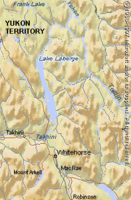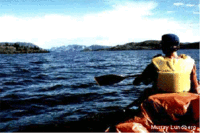Lake Laberge, Yukon Territory
| Topics: |
Physical Attributes
 (Source: Biodiversity Institute of Ontario)
(Source: Biodiversity Institute of Ontario) - Altitude: 628 m above sea level
- Surface Area: 201 sq km
- Mean depth: 54 m
- Maximum depth: 146 m
- Volume: 10.8 cu. km
- Drainage Basin: 31, 500 sq km (approximately 1300 sq km of the drainage basin is covered by large lakes).
General Description
 (Source: Biodiversity Institute of Ontario)
(Source: Biodiversity Institute of Ontario) Lake Laberge is a long, narrow riverine lake. The Yukon River flows through the lake, serving as both its inflow and outflow. The lake was formed by glacial activity during the last Ice Age and glacially derived sediments line the shores of the Yukon River. These deposits are easily eroded and carried into the lake. Lake Laberge is ultra-oligotrophic as a result of low nutrient levels and low light penetration. The Yukon's capital city, Whitehorse, is located upstream of the lake along the Yukon River. The Whitehorse economy is based around tourism and the lake offers fishing for lake trout as well as whitefish. Although the hydro-electric dam at Whitehorse has hindered salmon movement into the lake, the construction of fish ladders has largely compensated for this problem. The lake is otherwise only minimally impacted by human activity. Lake Laberge is best known for the poem written by Robert Service, entitled "The Cremation of Sam McGee".
"The Northern Lights have seen queer sights
But the queerest they ever did see
Was the night on the marge of Lake Labarge
I cremated Sam McGee"
Watershed
The drainage basin includes the continental side of the Coastal Mountains that range along the Canada-U.S. border and the Yukon intermontane plateau.